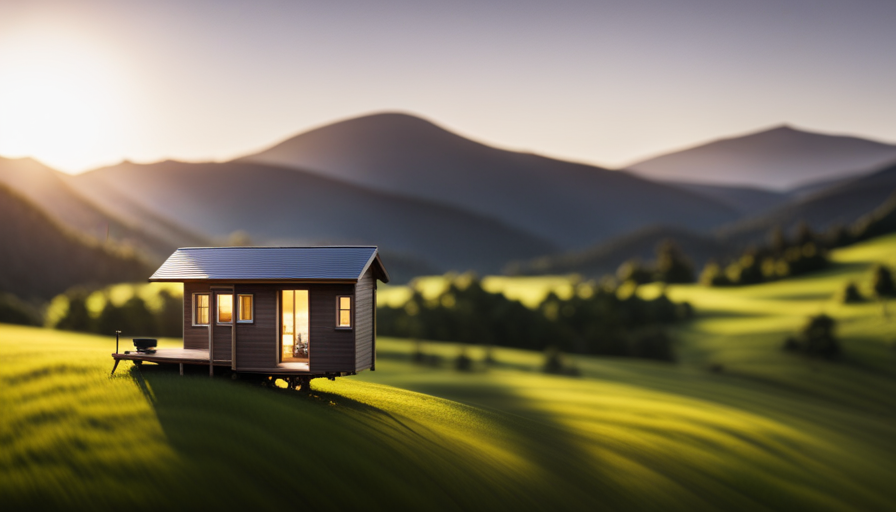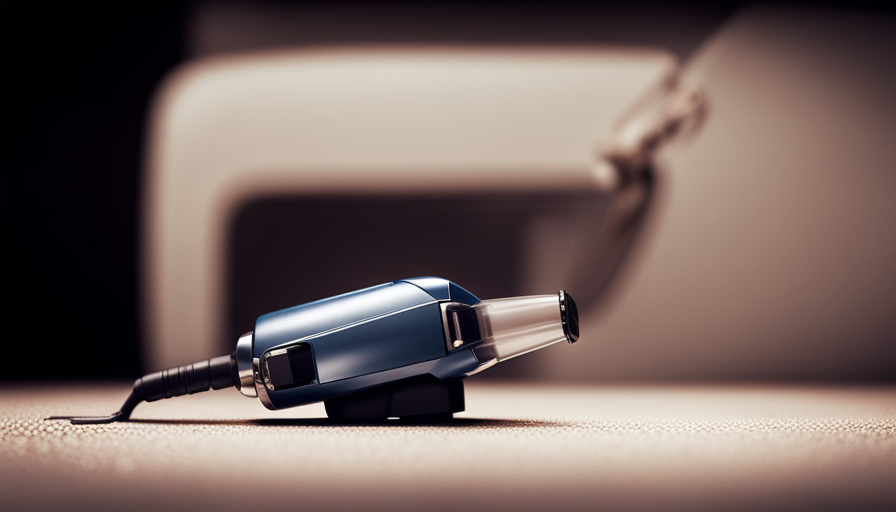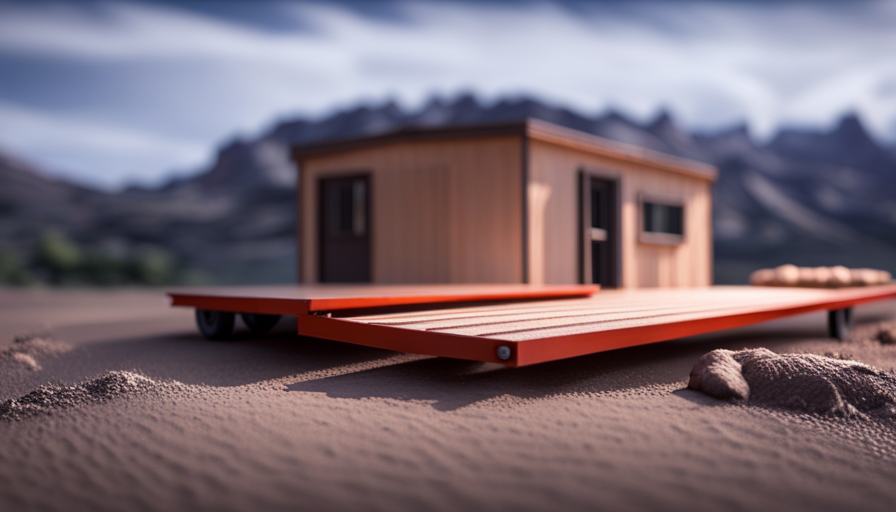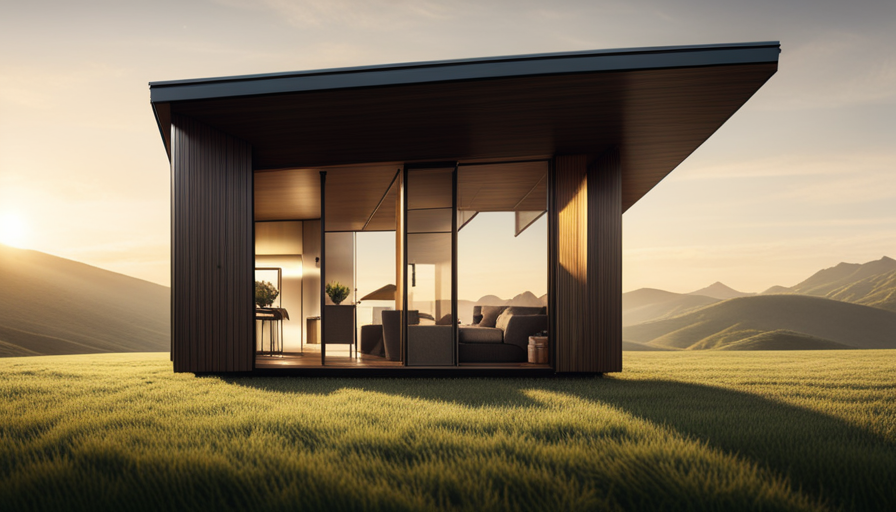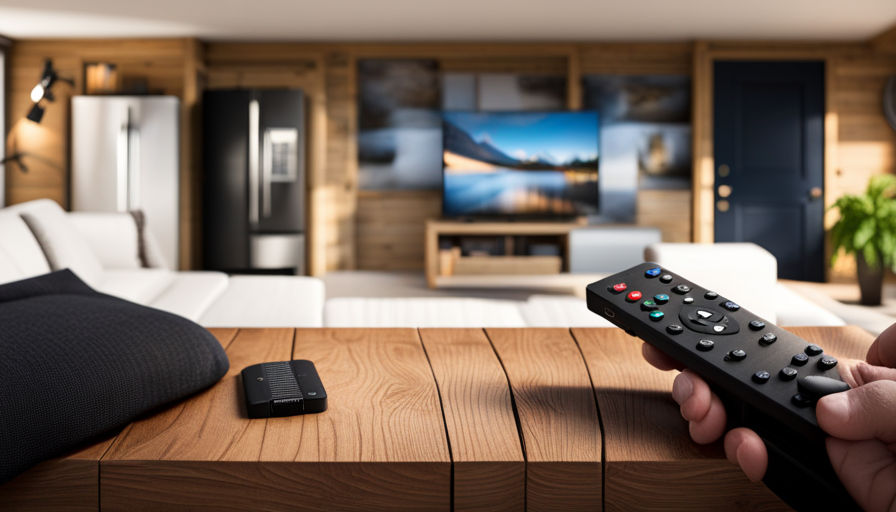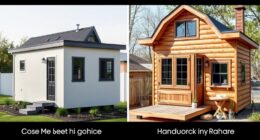Similar to how a puzzle piece fits perfectly into a complete picture, a tiny house offers a creative and cost-effective solution to meet the rising need for affordable housing. But one may ask, what is the specific price of a tiny house?
In this article, I will explore the factors that influence the cost of a tiny house, the different types available and their price ranges, as well as ways to save money when building or buying one. I will also delve into financing options and the pros and cons of living in a tiny house. Additionally, I will discuss the additional costs and expenses to consider, such as utilities and maintenance. Lastly, I will provide tips on designing and maximizing space in a tiny house, as well as real stories and testimonials from tiny house owners.
So, if you’re curious about the financial aspect of tiny house living, keep reading to uncover the data-driven answers you seek.
Key Takeaways
- Factors influencing the cost of a tiny house include materials, location, and customization.
- Tiny houses on wheels (THOWs) range from $30,000 to $100,000, while foundation-based tiny houses cost between $30,000 and $150,000.
- DIY builds save upfront labor costs but require purchasing materials and tools, while professional builds offer experience and quality craftsmanship but come with a higher price tag.
- Cost-saving strategies include using reclaimed materials, DIY construction, and simpler designs, as well as incorporating energy-efficient fixtures and appliances.
Factors that Influence the Cost of a Tiny House
The cost of a tiny house can vary depending on several factors, such as the materials used, the location, and the level of customization desired. These factors have a significant impact on the overall price of a tiny house.
One of the main factors affecting the cost of a tiny house is the materials used in its construction. Different materials have different price points, and some may be more expensive than others. For example, using high-end materials like hardwood floors or granite countertops will increase the cost of the house compared to using more affordable options.
The location of the tiny house also plays a role in its cost. The cost of land varies greatly depending on the location, and this can significantly affect the overall price of the tiny house. Additionally, the cost of utilities and permits may differ from one area to another, further impacting the total cost.
Another factor to consider is the level of customization desired. Popular tiny house designs often include unique features and customizations, which can increase the cost. For instance, adding solar panels or a composting toilet may be more expensive but can provide long-term cost savings.
The cost of a tiny house is influenced by factors such as the materials used, the location, and the level of customization desired. Understanding these factors is crucial when determining the price range for different types of tiny houses.
Types of Tiny Houses and Their Price Ranges
In this discussion, I’ll be exploring the different types of tiny houses and their corresponding price ranges.
First, we have tiny houses on wheels, which are mobile and offer flexibility in terms of location. These can range in price from $20,000 to $100,000 depending on the size and level of customization.
Second, we have foundation-based tiny houses, which are more permanent structures and typically cost between $30,000 and $150,000.
Lastly, we’ll delve into the choice between DIY builds and professional builds, considering factors such as cost savings and the level of expertise required.
Tiny Houses on Wheels
Imagine living in a home that can travel anywhere you want, all while saving money – have you ever wondered how much a tiny house on wheels costs?
Tiny houses on wheels, also known as THOWs, provide the flexibility of mobility and the convenience of a traditional house. When compared to foundation-based tiny houses, THOWs tend to be more affordable.
The cost of a tiny house on wheels can vary depending on factors such as size, materials used, and customization options. On average, a THOW can range from $30,000 to $100,000. However, it’s important to note that popular locations for tiny house living may affect the overall cost. For example, a THOW in a highly desirable area may have a higher price tag due to increased demand.
Moving on to the subsequent section about foundation-based tiny houses, let’s explore the costs associated with those dwellings.
Foundation-Based Tiny Houses
Get ready to experience the freedom and charm of living in your very own foundation-based tiny home – it’s time to discover the incredible affordability and endless possibilities that await you.
Foundation-based tiny houses offer a variety of cost-saving tips, making them an attractive option for those looking to live a minimalist lifestyle. When it comes to foundation options, there are several to choose from, including concrete slab, crawl space, and basement. Each option has its own advantages and costs, allowing you to find the best fit for your budget and needs.
Concrete slabs tend to be the most affordable, while basements offer additional living space but come with a higher price tag.
Now that you have a better understanding of foundation-based tiny houses and their costs, let’s explore the next section about ‘diy vs. professional builds’ to help you decide which route to take.
DIY vs. Professional Builds
Consider whether you’re up for the challenge of taking on a DIY build or if investing in a professional build will provide you with the peace of mind and expertise needed to create your dream foundation-based tiny home.
When it comes to DIY vs. professional builds, cost is a significant factor to consider. DIY builds can save you money upfront, as you won’t have to pay for labor costs. However, keep in mind that you’ll need to purchase materials, tools, and potentially hire subcontractors for certain tasks. On the other hand, professional builds may come with a higher price tag, but they offer the advantage of experience, quality craftsmanship, and streamlined construction.
Time is another crucial consideration. DIY builds often take longer, as you’ll need to balance your time with other commitments. In contrast, professional builders have the expertise and resources to complete the project efficiently.
Transitioning into the next section about the average cost of a tiny house, it’s important to understand that both DIY and professional builds can vary significantly in price.
Average Cost of a Tiny House
Looking to build your dream tiny house? Well, you’ll be thrilled to know that the average cost of a tiny house won’t break the bank! When considering the factors affecting tiny house pricing, it’s important to note that there are various cost-saving strategies for building a tiny house.
On average, the cost of a tiny house can range from $10,000 to $100,000, depending on factors such as size, location, materials used, and level of customization. The size of the tiny house is a significant factor in determining its cost, as larger tiny houses require more materials and labor.
Additionally, the location of the tiny house can impact the overall cost, with prices varying depending on the cost of land and local building regulations. By utilizing cost-saving strategies such as using reclaimed materials, DIY construction, and opting for simpler designs, individuals can significantly reduce the cost of building a tiny house.
These strategies can help individuals save money on their dream tiny house while still achieving their desired level of comfort and functionality.
Ways to Save Money on a Tiny House
When it comes to building a tiny house, there are numerous ways to save money without compromising on quality. By implementing cost-saving tips and utilizing sustainable building materials, you can create your dream tiny home while staying within your budget.
One of the most effective ways to save money on a tiny house is by being resourceful and creative. Instead of purchasing brand new materials, consider repurposing or upcycling items to reduce costs. Additionally, opting for energy-efficient appliances and fixtures can save you money in the long run by lowering your utility bills.
Another cost-saving strategy is to consider alternative construction methods. For instance, using recycled or reclaimed materials can significantly reduce the overall cost of your tiny house. Additionally, exploring alternative energy sources such as solar panels can help you save on electricity expenses.
Incorporating a 2-column and 3-row table, here are some cost-saving tips to consider:
| Cost-Saving Tips | |
|---|---|
| 1. Repurpose and Upcycle Materials | 2. Opt for Energy-Efficient Appliances and Fixtures |
| 3. Use Recycled or Reclaimed Materials | 4. Explore Alternative Energy Sources |
By implementing these strategies and utilizing sustainable building materials, you can save money while creating an environmentally friendly tiny house. Now, let’s explore the various financing options available for your tiny house project.
Financing Options for Tiny Houses
If you’re ready to turn your tiny house dreams into a reality, there are several financing options available to help you make it happen.
Tiny house financing options have become more prevalent in recent years as the demand for alternative housing solutions has grown.
One common option is to secure a traditional mortgage loan, although this can be challenging since tiny houses are typically not considered permanent structures. However, some lenders specialize in tiny house financing and may be more willing to work with you.
Another option is to explore personal loans, which can be used for various purposes including financing a tiny house. These loans typically have higher interest rates and shorter repayment terms, so it’s important to carefully consider the financial implications.
Additionally, some tiny house builders offer in-house financing options, allowing you to make monthly payments directly to the builder. This can be a convenient option, but be sure to review the terms and conditions before committing.
Ultimately, the financing option you choose will depend on your personal financial situation and goals. As you consider your options for financing a tiny house, it’s important to also think about other considerations such as location, size, and design. By carefully weighing these factors, you can make an informed decision that aligns with your needs and preferences.
Considerations for Choosing a Tiny House
When considering a tiny house, there are several key points to keep in mind.
First, lifestyle and space requirements play a crucial role in determining the right tiny house for you.
Secondly, it’s important to consider whether you’re looking for a long-term or temporary living arrangement, as this will impact the design and features you prioritize.
Lastly, resale value and future market trends should be taken into account, as they can affect the financial viability of your tiny house investment.
Lifestyle and Space Requirements
To truly embrace the minimalist lifestyle, you must consider the space requirements of a tiny house and how they can impact your daily life. Tiny houses offer numerous lifestyle benefits, such as reduced environmental footprint, lower utility costs, and simplified living. However, it’s crucial to determine if the limited space will suit your needs and preferences.
Assess your daily activities and possessions to ensure they can fit into a smaller living space. Consider if you’re comfortable with the idea of downsizing and decluttering your belongings. Additionally, think about your future plans and whether a tiny house can accommodate them. Transitioning from a traditional home to a tiny house may require adjustments, but it can provide a fulfilling and enriching experience.
Next, we’ll explore the differences between long-term and temporary living in a tiny house.
Long-Term vs. Temporary Living
When considering the lifestyle and space requirements of living in a tiny house, it’s important to also think about whether you plan to live in it long-term or temporarily. Long-term sustainability is a key factor to consider, as tiny houses are generally designed to be efficient, eco-friendly, and cost-effective over time.
In terms of cost comparison, living in a tiny house long-term can be significantly cheaper than renting or owning a traditional home. This is due to lower mortgage payments, reduced utility bills, and minimal maintenance costs. However, it’s important to carefully assess your long-term needs and ensure that a tiny house can meet them. It may be helpful to make a list of your must-haves and evaluate whether a tiny house can accommodate them.
This will ensure that you make an informed decision about whether living in a tiny house is a sustainable choice for you. Moving forward, let’s explore the resale value and future market trends of tiny houses.
Resale Value and Future Market Trends
Consider the potential for increasing demand and appreciation of tiny homes in the future, as their unique and sustainable design continues to gain popularity in the housing market. When it comes to resale value, tiny houses have shown promising trends. Due to their affordability and environmentally friendly nature, these homes are attracting a growing number of buyers, which could contribute to a rise in their market value over time.
Additionally, as the demand for sustainable housing options continues to increase, the future market for tiny homes is expected to remain strong. However, it is important to note that market trends can vary regionally, and factors such as location, amenities, and overall condition of the tiny house can also influence its resale value.
Keeping all these factors in mind, let’s now explore the pros and cons of living in a tiny house.
Pros and Cons of Living in a Tiny House
Living in a tiny house is like living in a cozy cabin, where you can snuggle up and enjoy the simplicity of life.
Downsizing to a tiny house has its pros and cons, and it’s important to consider the impact it can have on your mental health.
On the positive side, downsizing allows you to simplify your life and focus on what truly matters. With a smaller space, you’re forced to declutter and prioritize your belongings, leading to a more organized and stress-free environment. Additionally, living in a tiny house often means lower utility bills and maintenance costs, which can help alleviate financial stress.
However, there are also some potential drawbacks to consider. The limited space in a tiny house can make it challenging to entertain guests or have privacy when needed. It may also require some adjustments in daily routines, such as using smaller appliances or finding creative storage solutions. Furthermore, living in such a small space can be claustrophobic for some individuals and may not be suitable for those who require a lot of personal space.
While there are both pros and cons to living in a tiny house, it ultimately comes down to personal preference and lifestyle. Downsizing can have a positive impact on mental health by promoting simplicity and reducing financial stress. However, it’s important to weigh these benefits against the potential challenges of limited space and privacy.
Moving forward, it’s crucial to also consider the additional costs and expenses associated with owning a tiny house.
Additional Costs and Expenses to Consider
One thing to keep in mind is that there are extra expenses and fees associated with owning a tiny house. While the initial cost of purchasing a tiny house may be lower than that of a traditional home, there are additional costs that can add up over time. These additional costs include maintenance and repairs, utilities, insurance, and parking fees. It is important to budget for these expenses to avoid any surprises down the line.
| Additional Costs | Hidden Expenses |
|---|---|
| Maintenance | Permit Fees |
| Repairs | Land Rent |
| Utilities | Hookup Fees |
| Insurance | Off-grid Systems |
Maintenance and repairs are ongoing expenses that come with owning any home, and a tiny house is no exception. Additionally, utilities such as water, electricity, and internet will need to be factored into your monthly budget. Insurance is another cost to consider, as tiny houses may require separate coverage from traditional homeowners’ insurance.
In addition to these costs, there may be hidden expenses such as permit fees, land rent (if you don’t own the land), hookup fees for utilities, and the cost of implementing off-grid systems. These hidden expenses can quickly add up and should be taken into account when determining the overall cost of owning a tiny house.
Considering these additional costs and hidden expenses, it is important to carefully plan your budget and factor in all potential expenses before deciding to live in a tiny house. By doing so, you can ensure that you are financially prepared for the unique challenges and costs associated with tiny house living.
When it comes to designing and maximizing space in a tiny house, there are several tips and tricks that can help make the most of your limited square footage.
Tips for Designing and Maximizing Space in a Tiny House
Imagine your tiny house as a magical puzzle box, where every nook and cranny holds a hidden treasure of space-saving secrets. When it comes to designing a tiny house, maximizing space is crucial. With limited square footage, it’s important to utilize every inch wisely.
Here are some tips and techniques to help you make the most out of your tiny abode.
First and foremost, consider multifunctional furniture. Look for pieces that serve multiple purposes, such as a sofa that can transform into a bed or a coffee table with built-in storage. This way, you can maximize your space without sacrificing functionality.
Another tip is to utilize vertical space. Install shelves or cabinets that reach all the way up to the ceiling. This will not only provide additional storage, but also draw the eye upward, making the space feel larger.
Additionally, think about incorporating hidden storage solutions. Utilize under-bed storage, built-in drawers, and hidden compartments to keep your belongings organized and out of sight.
Lastly, embrace minimalism. Keep your belongings to a minimum and adopt a clutter-free lifestyle. This will not only make your space feel more open and inviting, but also make cleaning and maintenance easier.
By implementing these designing tips and space maximization techniques, you can create a functional and efficient tiny house that feels spacious and comfortable.
Now, let’s delve into real stories and testimonials from tiny house owners, who’ve successfully embraced the tiny living lifestyle.
Real Stories and Testimonials from Tiny House Owners
In my personal experience as a tiny house owner, I’ve gained valuable insights into the challenges and rewards of this unique lifestyle. Living in a tiny house requires careful planning and organization, but it also offers a sense of freedom and simplicity.
Based on my experience, I’d advise prospective tiny house buyers to carefully consider their needs and priorities before making the decision to downsize.
Personal Experiences and Insights
Wow, you won’t believe how much a tiny house actually costs! As a tiny house owner myself, I can provide some personal experiences and insights into the financial aspect of this lifestyle.
One of the biggest challenges I faced was the initial cost of building or buying a tiny house. Depending on the size, design, and materials used, prices can range from $20,000 to $150,000 or more. However, there are cost-saving tips that can help reduce expenses.
For example, opting for a DIY build, using reclaimed materials, or purchasing a pre-owned tiny house can significantly lower costs. It’s important to carefully consider your budget and prioritize your needs when making decisions.
Transitioning into the challenges and rewards of tiny house living, it’s clear that the financial investment is just the beginning of the journey.
Challenges and Rewards of Tiny House Living
Living in a tiny house presents both unique challenges and rewarding experiences that go far beyond just the financial investment. The challenges of tiny house living include limited space, lack of storage, and the need for creative organization solutions. However, these challenges can also be seen as opportunities for minimalism, mindfulness, and intentional living.
Benefits of tiny house living include reduced expenses, lower environmental impact, and the freedom to live a more mobile lifestyle. By downsizing and simplifying our lives, we can focus on what truly matters and find contentment in living with less.
Transitioning to the next section, for prospective tiny house buyers, it’s important to consider these challenges and benefits in order to make an informed decision about whether tiny house living is right for you.
Advice for Prospective Tiny House Buyers
Consider the investment of your future dream home and explore the possibilities of a cozy and efficient living space. When it comes to financing a tiny house, here’s some advice to keep in mind:
-
Research different financing options: Look into personal loans, RV loans, or even crowdfunding platforms specifically designed for tiny house projects. Compare interest rates and terms to find the best fit for your budget.
-
Consider your location: Before buying a tiny house, think about where you plan to park it. Some states have specific regulations and zoning laws for tiny houses, so make sure you understand the legalities involved.
-
Evaluate long-term costs: While the initial cost of a tiny house may be lower than a traditional home, don’t forget to consider ongoing expenses such as utilities, maintenance, and insurance.
By carefully considering financing options and location considerations, you can make an informed decision when buying your own tiny house.
Frequently Asked Questions
What are the most common factors that can increase the cost of a tiny house?
Factors affecting the cost of a tiny house include size, materials, location, and customization. Hidden expenses can arise from permits, utilities, and transportation. These factors can significantly increase the overall cost of building a tiny house.
Are there any unique types of tiny houses that have significantly higher price ranges?
Unique, expensive tiny houses, such as high-end designs with luxurious features and custom craftsmanship, can have significantly higher price ranges. These exclusive homes showcase exquisite details and unique architectural styles, attracting buyers willing to invest more for a one-of-a-kind living experience.
Can you provide some examples of additional costs and expenses that people often overlook when considering a tiny house?
Factors affecting the cost of a tiny house include location, size, materials, and customizations. When budgeting for a tiny house project, it is important to consider expenses such as land, permits, utilities, insurance, and maintenance costs.
Are there any tips on how to finance a tiny house without taking out a traditional mortgage?
Alternative financing options for tiny houses include personal savings, crowdfunding, RV loans, and peer-to-peer lending. Creative funding strategies such as renting out the tiny house or participating in tiny house communities can also help offset costs.
Can you share some real stories or testimonials from people who have successfully designed and maximized space in their tiny houses?
Real life success stories in maximizing tiny house space are inspiring. People have used creative storage solutions like built-in shelving, hidden compartments, and multi-purpose furniture. These designs optimize every inch, making tiny houses functional and comfortable.
Conclusion
After thoroughly researching the cost of tiny houses, it’s clear that there are several factors that influence their price. From the type of tiny house to additional expenses, it’s important to consider all aspects before making a decision.
While the average cost can range widely, there are ways to save money and financing options available. Living in a tiny house has its pros and cons, but with careful planning and design, it can be a unique and efficient living space.
Real stories and testimonials from tiny house owners further highlight the benefits and challenges of this lifestyle. Overall, the truth behind the theory is that the cost of a tiny house varies greatly, but with the right approach, it can be an affordable and fulfilling choice.
Hi, I’m Emma. I’m the Editor in Chief of Tiny House 43, a blog all about tiny houses. While tree houses are often associated with childhood, they can be the perfect adult retreat. They offer a cozy space to relax and unwind, surrounded by nature. And since they’re typically built on stilts or raised platforms, they offer stunning views that traditional homes simply can’t match. If you’re looking for a unique and romantic getaway, a tree house tiny house might just be the perfect option.
